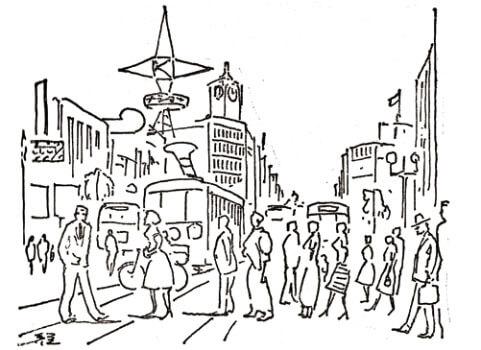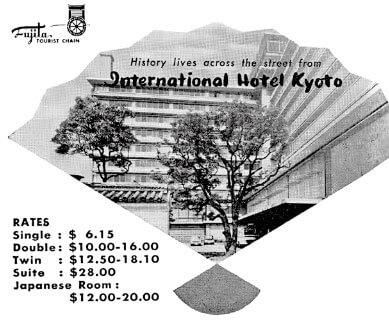Issue:

Memories are made of this
The 1966 Fodor’s guidebook is a benchmark for five decades of change.
by MARK SCHREIBER
To tweak his involuntary memory, French author Marcel Proust would bite into a small spongy cake called a “petite Madeleine de Commercy.” While considerably less prolific than Proust despite having been blessed with a longer lifespan (Proust died at 51) I recently found another way to unleash a flood of fond memories, by skimming through the 1966 edition of Fodor’s Guide to Japan and East Asia.
The 750 page monster, printed in Japan, sold for just $6.95, and I certainly got my money’s worth. Starting with an initial nineday visit to Japan in December 1965, it was to serve as my guidebook over the next several years in Japan, Hong Kong, the Philippines, South Korea, Taiwan, Thailand and South Vietnam.
I recently found a nearly mint copy of Fodor’s for $4.99 on Amazon.com. Upon opening it to the section on Japan, I was magically whisked back to the evening of Wednesday, Dec. 22, 1965. I’d turned 18 just a month earlier, and was accompanying my parents and younger brother on a propeller driven DC-6 aircraft flying from Kadena Air Base, Okinawa to Tachikawa Air Base in western Tokyo. The carrier was a front company for the Central Intelligence Agency called Southern Air Transport, whose initials, its passengers would acerbically remark, stood for “Sorry About That.”
The Japan I found back then is well described in the 34 page essay that makes up the opening section of Fodor’s. It was written by someone I would meet in person years later, and whose writings I would see a great deal of: Edward Seidensticker.
Given his impressive academic and literary credentials I suppose Seidensticker found writing it a rather easy task. Titled “Japan: A crowded, lonely land,” his essay begins: “Within seconds of his arrival, the visitor to Japan is immediately aware of one essential fact about the country. It is crowded. Whether he comes by ship or by plane, he finds himself immediately in the middle of the world’s greatest jumble of humanity, the Tokyo metropolitan complex. Other cities rival Tokyo in size, but none approaches it in noise, in bustle, in the rip and swirl of its roiling sea of bodies.”
On page 67, he justifies his title thusly: “The most obvious characteristic of the Japanese brings us back to the beginning: that they appear in crowds, and when they move they move in crowds, as if impelled by a terrible fear of being alone... “Although a Japanese is seldom alone, it may be said that he is frequently, perhaps even characteristically, lonely. Japan is not a society of relaxed, easy associations...
“All in all it is a chilly, fragmented, constricting world.” Some readers may recognize other names among Fodor’s team of contributors: Peter Robinson, former correspondent for the Sydney Morning Herald and Financial Times, produced articles on Food and Drink, Dining out in Tokyo and Hokkaido. Maggy Burrows, a native of New Orleans, wrote about shopping. Others included Francis King (Kyoto), Robert C. Fisher (Kyushu) and James Kirkup (Tohoku).
Robinson’s writing on cuisine comes across as enlightened, considering attitudes that prevailed at the time: “One of the greatest of Japanese dishes and one which seems to worry Westerners, at least before they taste it, most of all is raw fish. . . . Many foreigners who live in Japan feel that sushi is Japan’s greatest contribution to gastronomy; even those who don’t particularly like it, agree that it is much better than its ingredients . . . would indicate.”
He also writes: “Noboribetsu and other Hokkaido spas are among the relatively few remaining in Japan where mixed bathing between the sexes is common. However, many Western visitors will be surprised by how modest Japanese men and women can be with only a tiny wash towel. The prurient will find little of interest while the modest will probably be too overcome with shyness to experiment with mixed hot springs bathing. For the remainder, it should be an interesting and happy experience.”
Although it is not attributed, Robinson may have also produced this unabashed advisory. “A few years ago, when prostitution was legal in Japan, certain districts were set aside for it famed Yoshiwara was one. Such areas no longer exist, but the ladies of the profession are still plentiful. . . . Arrangements vary, but the usual procedure is to make a private deal with your companion, to escort her to a hotel [in addition to] the hotel bill, perhaps another two thousand yen, and her ‘present,’ perhaps three thousand if you wait until breakfast to reward her. Obvious newcomers may be asked for twice as much. It will all be done with the peculiar Japanese women’s charm, however, and your companion will explain everything to you without any apparent embarrassment.”
Robinson’s son Mark recalls his late father as “an extremely fast and prolific writer.”
“One thing about dad,” he says, “was he had no cultural chauvinism and very little ego. He simply accepted and enjoyed Japan for being different, and he carried very little Australian ‘baggage.’”
The ‘66 Fodor’s also contains several curious references that I confess to having no memory of whatsoever. One is its reliance on directions using the old street signs dating from the occupation period, with numbered streets and avenues designated “A,” “B,” “C” and so on.
Surprisingly, the section on Tokyo carries scant mention of the huge changes the city had undergone prior to the 1964 Olympics. And I was somewhat amazed to see that Japan’s vaunted shinkansen warrants all of one sentence: “The latest word in streamlined speed by rail was introduced in 1964 with the opening of the New Tokaido line, offering one of the world’s fastest services between the cities of Tokyo and Osaka.”
From the guide, it seems that Yasukuni Shrine, located on a street labeled “T” Avenue on the map, had yet to take on its present day political overtones. “Explore the shrine. . . You may walk about quite freely, though no one enters the actual shrine building. Indeed at any shrine, if the spirit moves you, you may toss a few copper coins in the box before the door, clap your hands to wake the gods within, fold them in prayer, bow your head for a moment and wish for something. The Japanese about you will be pleased and amused if you do this in your best Shrinemanship manner.”
My reacquaintance with the guidebook I’d relied upon half a century ago reminded me of how much Tokyo’s skyline has changed. Take this passage: As you approach the northern end of the palace grounds, you will see on your right, one of Tokyo’s first skyscrapers, the home of the Reader’s Digest and the Mainichi, one of Japan’s leading newspapers. Construction began in 1964.”
Today, The Mainichi Shimbun “skyscraper” is still occupied by its original tenant (although the Japanese edition of Reader’s Digest is long gone). It stands all of nine stories high.
The photos in the book also reminded me of so many everyday things that have vanished, like three wheeled trucks steered by handlebars, and Rabbit brand motor scooters. The military payment certificates (MPCs) I spent on the U.S. military bases are long gone; but then so are ¥100 and ¥500 bills.
Also celebrated in Fodor’s but no longer with us are the glitzy Akasaka night clubs like the Mikado (which I visited twice and came away unimpressed) and the New Latin Quarter, in the basement of the Hotel New Japan, whose main claim to fame was that 39 year old pro wrestler Rikidozan was fatally stabbed there by a gangster in December 1963. The hotel was permanently closed after a fire in February 1982, but the club survived until May 27, 1989.
I returned to Okinawa on New Year’s Day, 1966, and nine months later was back in Tokyo to study at International Christian University. Through sheer persistence I became more adept at the language. The head of my host family patiently drilled me how to read Japan National Railways’ massive monthly train schedule, which served as my Rosetta Stone to wander around the country. By the time I’d turned 21, my travels had taken me, with Fodor’s in hand, from Sapporo to Fukuoka and many points in between.
In his wisdom, Seidensticker wrote in his Fodor’s essay, “No one can honestly ask a stranger to come have a look, and expect him to derive much pleasure from his first impression. The visitor must rather be asked to stay until he has the feel of the place.”
I’m happy I took that advice to heart.

SOME CHOICE FODOR’S EXCERPTS:
Studying in Japan: The Japanese language has been called by one linguist, “the best excuse I ever knew for studying Spanish,” but if you wish to take the plunge….
Photography: We recommend that you send your Kodachrome and Ektachrome film to regular processing stations of the Kodak Company. You can arrange to have the film returned to your home address or anywhere else.
Overseas Calls: To call the United States. . . from Tokyo, dial 109 and tell the operator your number. Waiting time will be about 10 minutes. Charges to the US are ¥3,240 for 3 minutes on weekdays, ¥2,430 on Sundays.
Ryokan: Price range should be about $8 to $14 per person, with two meals. . .we have tried whenever possible to find quiet places where organized tours do not stay. The price range here will be from $4 to $6, with two meals included. . . but you may find more expensive rooms if you desire.
Trains: Fares run from ¥10 and up according to distance
Taxis: Taxis are cheap, and by reputation, suicidal. The old resident, however, ignores the usual effect of a Keystone Kops movie chase at headlong speed. He knows that for the most part the drivers have an uncanny skill and a way of repealing certain laws of physics, such as the one about two objects occupying the same space at the same time.
Motoring in Japan: The roads of Japan are slowly improving, but it is still a grueling experience to travel any distance by private car. Because of the extremely heavy traffic, the narrow roads and the absence of safety law enforcement, it is strongly recommended that you do not attempt to drive yourself outside of the major urban areas. It goes on to mention that rental rates are usually about $7.50 per day, including gas and oil.
Mark Schreiber currently writes the “Big in Japan” and “Bilingual” columns for the Japan Times.

